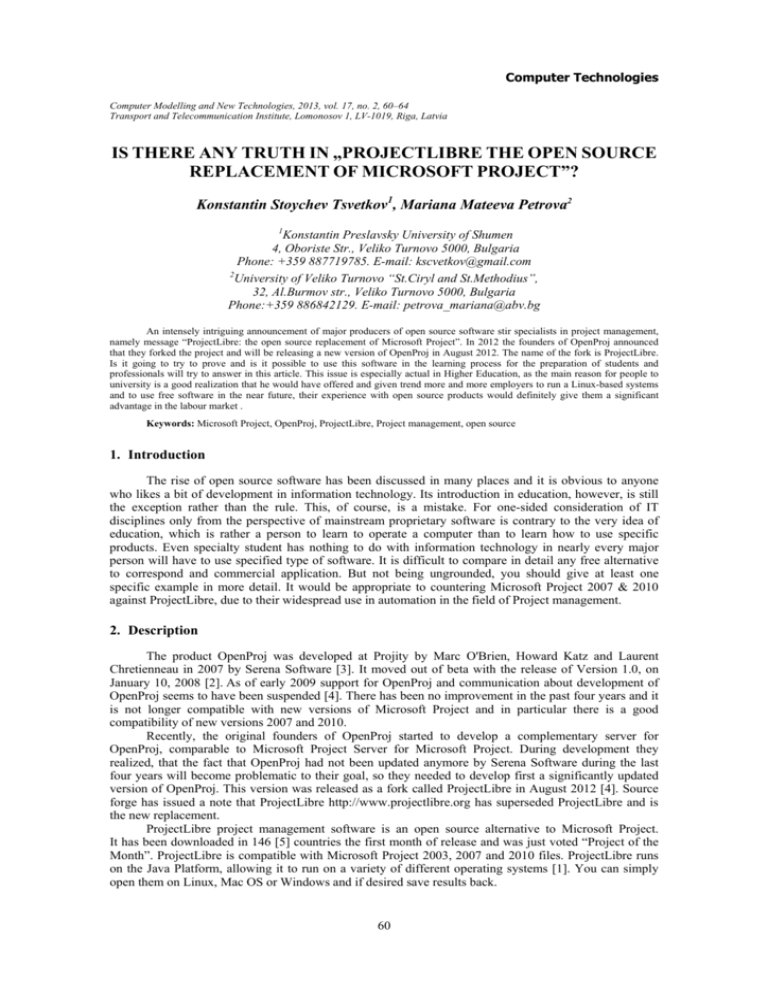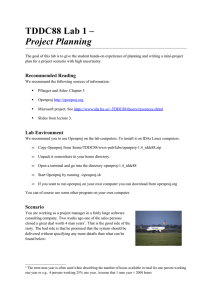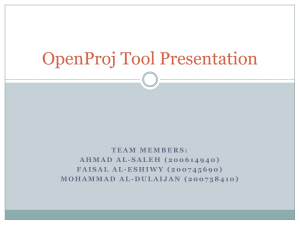„projectlibre the open source replacement of microsoft project”?
advertisement

Computer Technologies Computer Modelling and New Technologies, 2013, vol. 17, no. 2, 60–64 Transport and Telecommunication Institute, Lomonosov 1, LV-1019, Riga, Latvia IS THERE ANY TRUTH IN „PROJECTLIBRE THE OPEN SOURCE REPLACEMENT OF MICROSOFT PROJECT”? Konstantin Stoychev Tsvetkov1, Mariana Mateeva Petrova2 1 Konstantin Preslavsky University of Shumen 4, Oboriste Str., Veliko Turnovo 5000, Bulgaria Phone: +359 887719785. E-mail: kscvetkov@gmail.com 2 University of Veliko Turnovo “St.Ciryl and St.Methodius”, 32, Al.Burmov str., Veliko Turnovo 5000, Bulgaria Phone:+359 886842129. E-mail: petrova_mariana@abv.bg An intensely intriguing announcement of major producers of open source software stir specialists in project management, namely message “ProjectLibre: the open source replacement of Microsoft Project”. In 2012 the founders of OpenProj announced that they forked the project and will be releasing a new version of OpenProj in August 2012. The name of the fork is ProjectLibre. Is it going to try to prove and is it possible to use this software in the learning process for the preparation of students and professionals will try to answer in this article. This issue is especially actual in Higher Education, as the main reason for people to university is a good realization that he would have offered and given trend more and more employers to run a Linux-based systems and to use free software in the near future, their experience with open source products would definitely give them a significant advantage in the labour market . Keywords: Microsoft Project, OpenProj, ProjectLibre, Project management, open source 1. Introduction The rise of open source software has been discussed in many places and it is obvious to anyone who likes a bit of development in information technology. Its introduction in education, however, is still the exception rather than the rule. This, of course, is a mistake. For one-sided consideration of IT disciplines only from the perspective of mainstream proprietary software is contrary to the very idea of education, which is rather a person to learn to operate a computer than to learn how to use specific products. Even specialty student has nothing to do with information technology in nearly every major person will have to use specified type of software. It is difficult to compare in detail any free alternative to correspond and commercial application. But not being ungrounded, you should give at least one specific example in more detail. It would be appropriate to countering Microsoft Project 2007 & 2010 against ProjectLibre, due to their widespread use in automation in the field of Project management. 2. Description The product OpenProj was developed at Projity by Marc O'Brien, Howard Katz and Laurent Chretienneau in 2007 by Serena Software [3]. It moved out of beta with the release of Version 1.0, on January 10, 2008 [2]. As of early 2009 support for OpenProj and communication about development of OpenProj seems to have been suspended [4]. There has been no improvement in the past four years and it is not longer compatible with new versions of Microsoft Project and in particular there is a good compatibility of new versions 2007 and 2010. Recently, the original founders of OpenProj started to develop a complementary server for OpenProj, comparable to Microsoft Project Server for Microsoft Project. During development they realized, that the fact that OpenProj had not been updated anymore by Serena Software during the last four years will become problematic to their goal, so they needed to develop first a significantly updated version of OpenProj. This version was released as a fork called ProjectLibre in August 2012 [4]. Source forge has issued a note that ProjectLibre http://www.projectlibre.org has superseded ProjectLibre and is the new replacement. ProjectLibre project management software is an open source alternative to Microsoft Project. It has been downloaded in 146 [5] countries the first month of release and was just voted “Project of the Month”. ProjectLibre is compatible with Microsoft Project 2003, 2007 and 2010 files. ProjectLibre runs on the Java Platform, allowing it to run on a variety of different operating systems [1]. You can simply open them on Linux, Mac OS or Windows and if desired save results back. 60 Computer Technologies A ProjectLibre is envisaged that in the future to moan could be used as an alternative to a cloud/server replacement of Microsoft Project Server. On the site of OpenProj / ProjectLibre one can find various examples of projects. You can take advantage of opportunities to download, for each subproject that you remember, and the overall management of your business. Working with the program is very intuitive and hardly difficult even to those people who are not engaged in project planning. From a technical point of view, we do not comment on the performance of the program. Example proximity of MS project 2007 (Figure 1) with ProjectLibre (Figure 2) is the design of the task solved with both the products the conclusion is “it's the same”. When comparing MS Project and ProjectLibre (Figure 1 and Figure 2) clearly visible large external similarities between the two products. Fi Figure 1. Gantt chart of MS Project 2007 Figure 1 shows the Gantt chart for project implementation, it is used to test for compatibility option. Figure 2. Gantt chart in ProjectLibre 61 Computer Technologies 3. Comparison of Packages The most popular program in the field of project management is undoubtedly the package Microsoft Project. Microsoft Project is suitable for everyone who meets basic needs for project management and has a very large set of highly complex tools for collaboration and management. There is however one of its features, which certainly is not positive and this is the price – $ 999. Naturally for such a price, one has to wonder if there is any other program with similar functionality that would be compatible with MS Project and with a lower price. The answer is there and the price is so low that less cannot be – they are free. What are the main differences in the two platforms of Project management, implemented on the basis of open and proprietary software, which also belongs to the advantages/disadvantages comparing two packages? • Application based on open source is free. Everybody would have loved to use the free software that is legally free, not pirated. In the case of ProjectLibre it is, and in the words of its creators, it always will be free. • Updates open source application is also free. This is a direct consequence of the philosophy of the license under which it is running these applications. Microsoft updates are also generally free, but they can make them pay when they want without due explanation to someone about it. • Application code open source is outside the control of a single company. This makes applications independent of the current developers of these products and if the company disappears behind application code will be lost and the product can continue to live. • The application uses open source open standards. ProjectLibre file formats such as publicly documented, consistent and affordable. Many people do not understand what the advantage of file formats that are open is and their specifications are not known, but it is a great advantage in terms of transparency of what makes your computer data. It is also a great convenience for anyone who wants to create a product that is compatible with that format. Now let's get to the actual comparison of the two Project packages. General Stuff Microsoft Project and ProjectLibre are two very powerful desktop applications for project management with the following features: • Gantt chart. This is a bar chart that is used for project planning. It divides the design task into several subtasks and shows their relationship, start and end dates – Figure 1 and Figure 2. • Project Network. It shows “pre”, “next” and “intermediate” tasks in graphical mode; and called PERT chart; it is shown on Figure 3 and Figure 4. Again it is seen close to the same product of MS. Figure 3. Networking diagram of MS Project 2007 62 Computer Technologies Figure 4. Networking diagram of ProjectLibre • Resources Chart. These are the entries for the available resources listed to the right of the bars. • WBS (Work Breakdown Structure). Component structure of the work. It shows the structure of subordination and systematic breakdown of tasks into subtasks. • RBS (Resource Breakdown Structure). Resource breakdown or RBS is the categorization of resources according to different functions. • Output. Microsoft Project and ProjectLibre offer several methods for tracking consolidated financial statements and for the use of tasks / resources. Note: In this article we are not given any figures with diagrams near, but above are analogous according to the authors of the article to those of Figure 1–4. Some advantages of Microsoft Project • Rich supporting documentation. Microsoft Project has a really good support documentation that is available both online and offline, so that learning is easy. • Java is needed (debatable advantage). Unlike ProjectLibre, no need to install Java on your machine to run Microsoft Project. Some of the advantages of ProjectLibre • ProjectLibre is a free software project management, so you will save $ 700–1000. • Easy to system requirements. In most computers and ProjectLibre and Microsoft Project 2007 & 2010 will go smoothly. In older computers ProjectLibre will have a significant advantage. Its minimum requirements are a Pentium 166 MHz and 128 Mb RAM, while Microsoft Project 2007 & 2010 are Pentium 450 MHz with 266 Mb Ram. Which is more important, ProjectLibre and will run Linux (and Solaris and BSD), and Linux runs much more efficiently than older computers running Windows 2000 or XP. This makes Linux ProjectLibre practical combination even for very old computers. • Independence of the operating system. Multiplatform. This is undoubtedly one of the biggest advantages of ProjectLibre. It is available for each architecture, the three major 63 Computer Technologies platforms (Windows, Linux, and Mac). It relies on its Microsoft formats, and many others. Own file formats are extremely effective and generally the same document is smaller than the format as MS format. By comparison, Microsoft Project 2007 & 2010 only supports its own formats and is available only for Windows. • Usability, Training, Support. In general, anyone who has used MS Project 2003 & 2007 & 2010 will be feeling comfortable with ProjectLibre. Interfaces are almost identical, see Figure 1 and Figure 2; even in ProjectLibre syntax is identical. You can think of migration as ProjectLibre migration to Microsoft Project 2007 & 2010. While this is slightly different, but the concepts are the same. • Part of Star Office. OpenProj by 2008 it was a part of Star Office at Sun Microsystems [6], we assume a large percentage of security as its successor and ProjectLibre becomes a part of the package. Be asked if there are other programs like ProjectLibre, can confidently answer “Yes” and such are Gantter [41], Teambox [7], Rally Community Edition [8], FreedCamp [9], and many others. 4. Conclusions In conclusion, we emphasize three things. Firstly, the differences between the philosophies of open and closed software mentioned in the beginning, is perhaps the most important argument in favour of this application. These are advantages, which cannot be neutralized or removed, no matter how its competitors change. Secondly, the flexibility of open source software should be used to implement partial least in the beginning, if possible overall migration. Many open source programs have versions for Windows. Using ProjectLibre under Windows, it saves money; even Windows have to be paid or otherwise. Sometimes a person just needs the specific commercial applications. But he does not have to use them on Windows. One can use commercial software, without having to pay extra for Windows. And finally, the third thing I want to point out is that financial arguments in favour of open source are far from the most important ones. Since so much of open source programs are free, it creates a false impression to some people that these are decisions for poorer ones, and as such are incomplete. These people carry the logic of the material world, where it has no place. And since we're talking about higher education, I can say that even Harvard began steps for the introduction of open source software in their curricula (for we are not ungrounded – news can be found at http://news.cnet.com/8301 -13505_3-9916323-16.html) and they all would agree, it is certainly not suffering from a shortage of funds, so the example is quite telling, considering the topic of this report. Acknowledgement The article was designed by project РД-05-282/15.03.2012 of Konstantin Preslavsky University of Shumen. References 1. Heck, Mike. Preview: OpenProj brings free, robust project management to the desktop. InfoWorld. International Data Group. Retrieved August 11, 2007, from http://weblog.infoworld.com/tcdaily/archives/2007/10/preview_openpro.html 2. OpenProj 1.0 Released. SourceForge.net. Retrieved January 17, 2008, from http://sourceforge.net/forum/forum.php?forum_id=775275 3. Serena Software Acquires Open Source Alternative to Microsoft Project. Serena Software. Retrieved January 19, 2009, from http://www.serena.com/company/news/pr/spr_09232008.html 4. http://en.wikipedia.org/wiki/OpenProj#cite_note-IW200710-0 5. http://sourceforge.net/projects/projectlibre/ 6. http://en.wikipedia.org/wiki/OpenProj 7. https://app.gantter.com/ 8. http://teambox.com/ 9. http://www.rallydev.com/product-features/rally-community-edition 10. http://freedcamp.com/ 64









